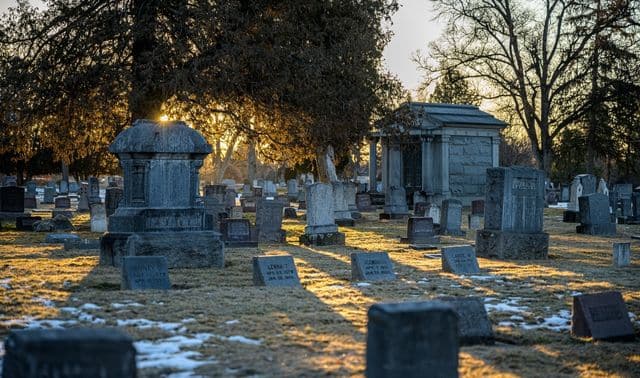Sign up for the Family Tree Newsletter Plus, you’ll receive our 10 Essential Genealogy Research Forms PDF as a special thank you!
Get Your Free Genealogy Forms
"*" indicates required fields
Soon after moving to Ohio, my husband and I discovered that one of his ancestors was buried in our tiny town — you can imagine our excitement. But when we found Daniel Kent’s marble tablet, it was broken, facedown in the mud and nearly illegible.
Sadly, many family tombstones are themselves at death’s door. In the process of trying to fix Daniel’s marker, I learned that while it’s possible to revive, repair or replace a stone, some “fixes” lead to premature death. Others address one problem and cause another. Before undertaking your own monumental makeover, consider these tombstone caretaking tips from professionals.
Fresh faces
The first principle of tombstone conservation is the same as any other kind of heirloom preservation: Educate yourself first, so you cause no harm. When preserving an ancestor’s tombstone, you first need to learn what material the stone is. Before 1900, most monuments were made from “soft” rocks such as sandstone, slate, limestone and marble. These types of rock carved easily with the available tools, and the short-term results were attractive — but the stones haven’t endured harsh climates or pollution well. Negligence and vandalism have added to their misery. Harder, more-durable granite tombstones replaced soft rock after the invention of pneumatic carving tools in the 1880s.
After you know the type of stone used, your first impulse in caring for or reviving the old tombstone is probably to clean it. Cleaning gives a tombstone a cared-for appearance, improves the legibility of the inscription and can prepare it for repair. Cleaning also removes stains caused by pollutants, dirt, rocks and plants, and reveals the stone’s original beauty.
But don’t pull out your scrub brush and Clorox. Stone conservator Ta Mara Conde, a board member of the Associationfor Gravestones Studies (AGS) and chair of its conservation committee, says 90 percent of her work is correcting good intentions. “I preserve stones to help genealogists in their work, but sometimes I have to protect the stones from genealogists,” she says. “Do not do something irreversible.” Bleach, for example, can permanently stain marble yellow and kill the heirloom roses around Great-grandma’s grave.
If you decide to clean a stone, conservators recommend doing so by adhering to the old adage “less is more.” Start with a simple water rinse — water might be the only cleaning agent you need. It’s also the least damaging, and is the only cleaner recommended for all stone types.
Avoid abrasives such as high-pressure water, sandblasting, wire brushes, steel wool and harsh scrubbing. If you must scrape or scrub, do so gently, using soft natural- or plastic-bristle brushes and wooden (not metal) implements such as tongue depressors. Clean from the bottom up to avoid streaking. Don’t clean a stone that’s eroding, brittle or fragile.
The National Center for Preservation Technology and Training also warns never to use “bleach, cleaners with salt or any strong acids or bases.” Instead, opt for gentle, non-ionic cleaners with a neutral pH, such as Triton X-100 or Tergitol (available from Talas).
Even seemingly benign household substances can do more harm than help. “Please, never use shaving cream or chalk on a monument,” Conde says.
The AGS website’s FAQ page lists acceptable cleaning chemicals for different types of old stones and the concentration to use. If you do use a chemical cleaner, soak the stone with water first. Soaking the stone keeps the chemical cleaner on the stone’s surface. Test the cleaner on a small portion of the stone before applying it to the entire stone. End with a thorough water bath again so no residue remains. (See Conde’s recommended recipe for a safe cleaner below.)
Microbiological growth (fungi, lichen, algae and moss) breaks down stone by attaching to it and holding moisture against it. Some stone experts believe it occasionally should be removed with an approved biocide, such as D/2 Biological Solution (find it at http://www.cathedralstone.com). D/2 is said to remove organic growth from stones and masonry without harm to people, stones or surrounding vegetation or wildlife. It sprays on, with little or no scrubbing required, and a treatment can last for one year or longer.
But not all stone professionals advocate removing microbiological growth. “The jury is still out whether lichens or other rock-growths protect or destroy stones,” says Judy Jacob, a senior conservator for the National Park System Northeast Regional Office. “Removal of growth could make the bare stone more vulnerable to pelting rain.”
Jacob has stopped cleaning gravestones because the growth eventually comes back and small amounts of stone are always lost with each cleaning. She also believes that every stone and environment is different, so no one solution fits all circumstances. “It’s up to the family to make an informed decision” about how to care for the stone, Jacob says.
Surgical solutions
When my fourth-great-grandmother’s marble stone fell apart 50 years ago, a cousin invented an iron strapping mechanism to hold it together. Thanks to his intervention, the stone still exists, but it’s now permanently rust-stained and has holes in the marble.
Thankfully, the field of stone conservation has come a long way since then and now provides us with better options and new products. Consider these three options to repair a broken stone:
- Epoxies and adhesives: Pick up an environmentally friendly masonry adhesive such as masonRE Adhesive (available from Cathedral Stone), which allows the transmission of water through the repair site. Don’t grab a “miracle epoxy” from the hardware store. Those epoxies stop water at the repair site, leading the surrounding rock to disintegrate.
- Reinforcing rods: You can use stainless steel, fiberglass or other strong, non-rusting rods as blind dowels on the inside of the stone to reinforce and hold two large pieces of stone together. This procedure can be paired with masonry adhesive (above) for long-lasting repair of broken monuments. Unless you’re knowledgeable in masonry techniques, however, this advanced repair requires a professional.
- Resetting the stone: When a stone tilts severely out of plumb or sinks deeply in the ground, it needs to be reset — another job for professionals. Author Lynette Strangstad details the process in A Graveyard Preservation Primer (AltaMira Press). Most important, conservators advise never to use concrete to reset an old stone. “Concrete is stronger and over time will crush the stone. Tombstones set directly in concrete will snap off at the base,” says AGS’ Conde. Instead, use historic lime mortar, available through many heritage building supply companies.
What if a stone has symptoms of something more than aging, such as encrustations, stains or heavy moss? Darlene and Rick Tichy, owners of Sheffield Monuments in Chagrin Falls, Ohio, say the problem is environmental. Check the stone’s neighborhood for causes of damage: Salt — from the water used to irrigate the lawn, a nearby ocean or snow removal on walkways, roads or even an overhead bridge — will deteriorate all stone, including granite. Heavy shade encourages moss and other biological growth. Trees can engulf stones as their roots dislodge them and heavy branches fall on and crush them. Bird droppings stain. Groundhogs and other burrowing animals undermine.
“The archenemy of the old stone is the lawn mower,” Conde says. “The operator often moves footstones, tosses away broken pieces of monuments, hits the tombstone with the mower and chips or breaks it.”
The Tichys add that the oils in some common cemetery items, such as roses, other flowers, wax and weed killer, will stain granite monuments.
Although you can’t prevent acid rain or diaper passing birds, you can protect your family grave markers to some extent. Consult with the cemetery about clearing shade-producing plants or overgrown foliage (be careful of any heirloom plants). Ask the cemetery to use a plastic line weed whip instead of a power lawn mower around the stones.
Beyond resuscitation
A tombstone is beyond resuscitation when the stone itself deteriorates: Sandstone crumbles. Marble “sugars,” becoming rough and powdery. Slate delaminates, or flakes apart.
“I’ve seen wealthy families spend thousands of dollars [trying to save] an old tombstone that isn’t going to last much longer anyway,” says second-generation stonemason Aaron Wolk, Cathedral Stone’s distribution manager. “No matter how much money you are willing to spend, the repair will only be as good as the stone structure itself.”
Wolk says that if the stone has multiple breaks or pieces missing and the inscription is less than 20 percent readable, it’s beyond repair.
Such was the case with Daniel Kent’s stone: The tablet was too thin to dowel, and the marble was sugared. The inscription had eroded, and too many pieces were missing to be able to repair it. You may eventually decide, as we did, to replace your ancestor’s stone so the grave will continue to draw descendants. When choosing a new stone, follow this advice from the professionals:
- Look for a design that will be appropriate in context with the surrounding stones.
- If you choose granite instead of the original stone, try to match other details — color, dimensions, font and style. We picked an unpolished, light-colored Barre, Vt., granite tablet, which bears the same inscription as the original.
- Note on the cemetery record or on the stone itself who placed the new marker and when. We also added the death date and place of Nancy Kent (Daniel’s wife).
- If you add a new stone but keep the old in place, ensure the markers don’t obscure views of each other. For example, you might add a low-to-the-ground granite marker at the base of an old marble column.
- If the cemetery doesn’t allow more than one marker, store the old stone indoors (if possible) and share its history with family members. Can’t find a home for the stone at the cemetery or in your family? Ask the local historical society whether it keeps old stones.
Admittedly, options for storing heavy tombstones are few — but you can avoid completely losing a marker’s history. Put a record and a photo of the stone in a nearby genealogical repository, and/or post photos of the old and new stones on a website such as Find a Grave.
Because of the efforts of my family and me, a descendant looking for Daniel Kent in the future will see not just a legible, dignified stone, but also the original marble tablet that Nancy erected over his grave in 1853. Don’t wait till it’s too late to preserve the stories of your own ancestors’ stones.
Tip: As Darlene Tichy points out, “Cemeteries have varying guidelines about what changes can be made and who can make them.” Even in abandoned cemeteries, check for regulations and get permission before altering a grave site.
More Online
Free Web Content
For Plus Members
Family Tree Shop
From the September 2011 issue of Family Tree Magazine
More great genealogy resources from Family Tree Magazine:
ADVERTISEMENT




